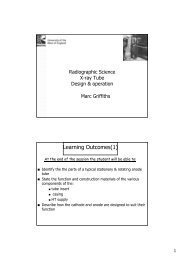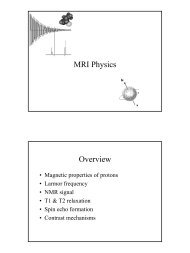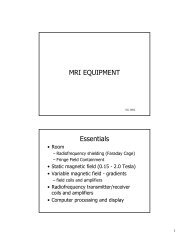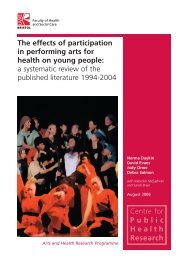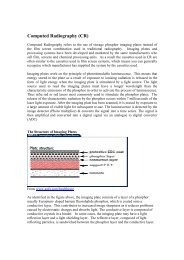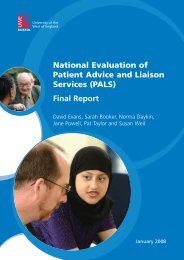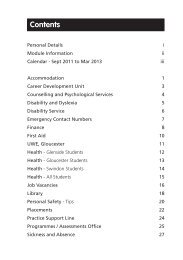Literature Review - HSC Home - University of the West of England
Literature Review - HSC Home - University of the West of England
Literature Review - HSC Home - University of the West of England
Create successful ePaper yourself
Turn your PDF publications into a flip-book with our unique Google optimized e-Paper software.
outcomes including depression, elevated blood pressure and reducedimmune functioning (Ulrich et al., 1991).Environmental features that affect patient outcomes include noise, lighting,colour, windows, views and art. Research suggests a number <strong>of</strong> negativeeffects <strong>of</strong> excessive or unwanted sound, including sleep deprivation (Simpsonet al., 1996), are associated with a number <strong>of</strong> negative physiologicaloutcomes (Topf and Davis, 1993). The review highlights earlier research thathas demonstrated that patients’ experiences in hospital are affected by <strong>the</strong>presence or absence <strong>of</strong> a window (see for example Ulrich, 1984). Work byUlrich (1992) on <strong>the</strong> role <strong>of</strong> art in hospital is also discussed. Artworks thatfeature images that hold <strong>the</strong> attention and create a positive distraction fromworries and invasive thoughts are seen as <strong>of</strong> most benefit. These include: Nature elements, such as trees, plants and water. Happy, laughing or caring human faces. Benign animals, such as pets.The 2000 review by Day et al., (2000) focuses on design and dementia,including facility planning, environmental attributes, building organisation, all<strong>of</strong> which are increasingly recognised as an important aid in caring for peoplewith dementia. The review includes 71 empirical studies published from 1980onwards.The review identifies a number <strong>of</strong> characteristics <strong>of</strong> <strong>the</strong> environment that canhave an impact on this group. For example, residents’ orientation can beaffected by factors such as noise and lighting, while orientation can beimproved by design features such as colour. While <strong>the</strong>re is relatively littleemphasis on arts, <strong>the</strong> review does consider o<strong>the</strong>r planning principles relevantto our research including relocation to new environments. A number <strong>of</strong>studies cited in <strong>the</strong> review suggest that when people are moved toge<strong>the</strong>r asan intact group, to residents and staff <strong>the</strong>re are few negative effects <strong>of</strong>relocation (Anthony et al., 1987; McAuslane and Sperlinger, 1994). However,residents with dementia who are moved individually appear to suffer higherrates <strong>of</strong> depression and mortality (Anthony et al., 1987; Robertson et al.,1993). The extent to which <strong>the</strong>se studies considered <strong>the</strong> quality <strong>of</strong> <strong>the</strong>environment in relation to <strong>the</strong> effects <strong>of</strong> relocation is unclear, although onestudy suggests that <strong>the</strong> more pleasant environment <strong>of</strong> a new facility maypartially explain <strong>the</strong> lack <strong>of</strong> negative impact for relocated residents(McAuslane and Sperlinger, 1994).The review notes that <strong>the</strong> majority <strong>of</strong> studies were based on small samplesizes. These are included as <strong>the</strong>y reflect <strong>the</strong> limited populations <strong>of</strong> residentsat single facilities in which most <strong>of</strong> <strong>the</strong> research took place. Never<strong>the</strong>less, <strong>the</strong>authors conclude that fur<strong>the</strong>r research is needed to build on <strong>the</strong>se exploratorystudies in order to investigate <strong>the</strong> <strong>the</strong>rapeutic use <strong>of</strong> design in dementia care.The final review discussed in this section focuses specifically on <strong>the</strong> evidenceregarding <strong>the</strong> effects <strong>of</strong> improvements in hospital design and construction on<strong>the</strong> occurrence <strong>of</strong> nosocomial infections (Dettenk<strong>of</strong>er et al., 2004). Although it22






